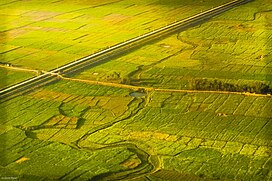| Terai | |
|---|---|
 Aerial view of Terai plains near Biratnagar, Nepal | |
| Ecology | |
| Realm | Indomalayan realm |
| Animals | gharial, mugger crocodile, king cobra |
| Bird species | Bengal florican, lesser adjutant, swamp francolin, white-rumped vulture, Oriental darter, sarus crane |
| Mammal species | Indian rhinoceros, Asian elephant, gaur, blackbuck, tiger, leopard, jungle cat, fishing cat, leopard cat, smooth-coated otter, large Indian civet, Asian palm civet, small Indian civet, hispid hare |
| Geography | |
| Countries | Nepal, India |
| Elevation | 67–300 m (220–984 ft) |
| Rivers | Sharda River, Karnali River, Gandaki River, Koshi River |
| Climate type | tropical savanna climate |
| Soil types | alluvial |
| Conservation | |
| Global 200 | Terai-Duar savanna and grasslands |
The Terai or Tarai is a lowland region in parts of southern Nepal and northern India that lies to the south of the outer foothills of the Himalayas, the Sivalik Hills and north of the Indo-Gangetic Plain. This lowland belt is characterised by tall grasslands, scrub savannah, sal forests and clay rich swamps. In North India, the Terai spreads from the Yamuna River eastward across Haryana, Uttarakhand, Uttar Pradesh, Bihar and West Bengal. The Terai is part of the Terai-Duar savanna and grasslands ecoregion.[1] Nepal's Terai stretches over 33,998.8 km2 (13,127.0 sq mi), about 23.1% of Nepal's land area, and lies at an elevation of between 67 and 300 m (220 and 984 ft). The region comprises more than 50 wetlands. North of the Terai rises the Bhabar, a narrow but continuous belt of forest about 8–12 km (5.0–7.5 mi) wide.[2]
- ^ Johnsingh, A. J. T.; Ramesh, K.; Qureshi, Q.; David, A.; Goyal, S. P.; Rawat, G. S.; Rajapandian, K. & Prasad, S. (2004). Conservation status of tiger and associated species in the Terai Arc Landscape, India. RR-04/001 (Report). Dehradun: Wildlife Institute of India. Archived from the original on 13 April 2020. Retrieved 31 December 2017.
- ^ Bhuju, U. R.; Shakya, P. R.; Basnet, T. B. & Shrestha, S. (2007). Nepal Biodiversity Resource Book. Protected Areas, Ramsar Sites, and World Heritage Sites (PDF). Kathmandu: International Centre for Integrated Mountain Development; Government of Nepal, Ministry of Environment, Science and Technology; United Nations Environment Programme, Regional Office for Asia and the Pacific.